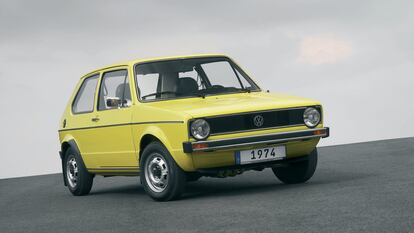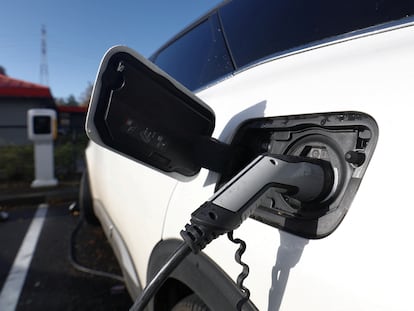Fifty years of the iconic Volkswagen Golf
The first universal compact model has become a coveted symbol and has been a sales leader for decades

It was a brilliant idea. The Golf saved Volkswagen at a critical moment for the company, and the model has been essential in making the German manufacturer the second most important one in the world, behind only Japan’s Toyota.
In the early 1970s, the oil crisis had hit the automobile industry hard. And Volkswagen was in a very fragile state.
Designed in the early 1940s, Volkswagen’s popular Beetle model was more than a little obsolete as compared to the modern Japanese compact models that were beginning to arrive in Europe.
But the solution came from the company’s own competencies, which by the end of the 1960s had taken over the NSU and Audi brands. Thanks to this technological potential, the Golf was developed in complete secrecy by a group of enthusiastic engineers, and their work provided solutions that were as successful as they were revolutionary.
Unlike its venerable predecessor, the Golf adopted a front-mounted engine and transmission instead of a rear-mounted one, but it was also a much more practical concept than the Beetle; it was much more dynamic as well. To top it all off, the Golf had a very successful aesthetic, designed by prestigious Italian stylist Giorgetto Giugiaro.
The first Volkswagen Golf went into production on March 29, 1974. Since then, almost 40 million cars, from eight successive generations, have been sold worldwide.
Three or four doors and a convertible body
However, this model had a difficult mission: it was intended to continue in the steps of the incombustible Beetle, of which over 20 million had already been sold in the early 1970s.
From the beginning, in addition to its revolutionary mechanical modernity, the Golf offered different variants: three or four doors, sports versions, a diesel engine (1976) and a convertible body (1979).
Those engineers’ exceptional work bore commercial fruit with the car’s unprecedented success. Just 10 years after its launch, the first-generation Golf had already exceeded seven million registrations and became an object of desire for drivers of all ages, both for its quality and for the originality of its approach.
In 1983, the second generation of the Golf perfected numerous details, and it grew in size from the 3.72 meters (12.2 feet) of the initial model to 3.99 meters (13.09 feet).
The new model also introduced major mechanical innovations, such as the Syncro version’s incorporation of permanent all-wheel drive, an exhaust pipe with a gas catalytic converter, an anti-lock braking system ABS (1986) and power steering.
A six-cylinder engine
The Golf’s 1991 third model changed its look, although that received criticism from its more purist followers. The characteristic bodywork abandoned the vehicle’s angular appearance, and the car’s classic circular headlights also disappeared. The design evolved in favor of the prevailing trend at the time, softer lines and rounded edges.
Mechanically, the model came of age with the debut of the 174 hp VR6 six-cylinder engine, a milestone for the sportiest compact cars.
The Golf’s legendary direct injection diesel engine, airbags and the first version with the Variant family body also began in this generation.
When the Golf IV arrived in 1997, it was distinguished by completely new bodywork that was more stylish and sporty, along with a major improvement in the interior finish. Already belonging to the era of electronics, it incorporated the ESP stability control, and the integral transmission version evolved into a new, more efficient system known as 4Motion.
A step toward electrification
Volkswagen launched the fifth version of the Golf in 2003. And, while it was the model’s shortest edition, it stood out as the first one that broke the 200-hp-power barrier with its sporty GTI version, which was decked out especially for the occasion with a very colorful special finish.
Only five years later, the replacement arrived. New driving assistance technologies accelerated the switch, and the Golf VI was quickly brought up to date. Among other innovations, it incorporated cruise control, hill start assist, automatic dipped headlights, the Park Assist parking system and, as the icing on the optional list, a chassis with DCC-adaptive damping.
Next, the German compact underwent a radical but invisible revolution (it was hidden within its own structure). The 2012 seventh-generation Golf was the first to be developed in the Volkswagen Group’s MQB modular platform. This made it possible to drastically reduce the vehicle’s weight, despite already reaching a considerable size for a classic compact (4.25 meters, or nearly 14 feet).
Since then, new technology has allowed for electrifying the model’s mechanics with a plug-in hybrid GTE variant and another 100% electric version, called e-Golf.
Nearly a half-century old
In 2017, the current Golf was introduced as the most efficient in its history. In addition, it featured all the technology necessary to be a connected car and had technology that had previously only been seen in higher categories. The vehicle range adapted to the new times with a variety of engines: gasoline, diesel, micro-hybrid, plug-in hybrid and pure electric.
Now the legendary model, which will celebrate its half-century of existence next year, is preparing to evolve in new ways. In 2024, the Golf will celebrate its 50th anniversary with a design update that emphasizes its sportier side, and it will retool the chassis in order to retain the superior dynamic that has always characterized this model.
Following tradition, the Golf’s catalog will continue to offer the sportiest versions, R and GTI, which have been star vehicles in the range over the years for different generations.
Later, the Golf will make the definitive leap to being a purely electric car. While it will presumably continue to be called Golf, by definition it will be integrated into Volkswagen’s ID range of 100% electric cars. That transition, from which there is no going back, will take place at the end of this decade.
Sign up for our weekly newsletter to get more English-language news coverage from EL PAÍS USA Edition
Tu suscripción se está usando en otro dispositivo
¿Quieres añadir otro usuario a tu suscripción?
Si continúas leyendo en este dispositivo, no se podrá leer en el otro.
FlechaTu suscripción se está usando en otro dispositivo y solo puedes acceder a EL PAÍS desde un dispositivo a la vez.
Si quieres compartir tu cuenta, cambia tu suscripción a la modalidad Premium, así podrás añadir otro usuario. Cada uno accederá con su propia cuenta de email, lo que os permitirá personalizar vuestra experiencia en EL PAÍS.
¿Tienes una suscripción de empresa? Accede aquí para contratar más cuentas.
En el caso de no saber quién está usando tu cuenta, te recomendamos cambiar tu contraseña aquí.
Si decides continuar compartiendo tu cuenta, este mensaje se mostrará en tu dispositivo y en el de la otra persona que está usando tu cuenta de forma indefinida, afectando a tu experiencia de lectura. Puedes consultar aquí los términos y condiciones de la suscripción digital.
More information
Archived In
Últimas noticias
Most viewed
- Oona Chaplin: ‘I told James Cameron that I was living in a treehouse and starting a permaculture project with a friend’
- Sinaloa Cartel war is taking its toll on Los Chapitos
- Reinhard Genzel, Nobel laureate in physics: ‘One-minute videos will never give you the truth’
- Why the price of coffee has skyrocketed: from Brazilian plantations to specialty coffee houses
- Silver prices are going crazy: This is what’s fueling the rally










































